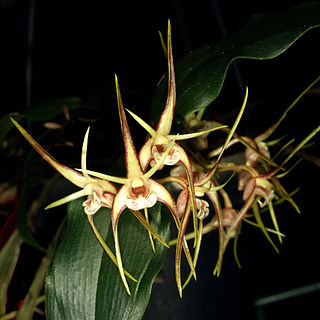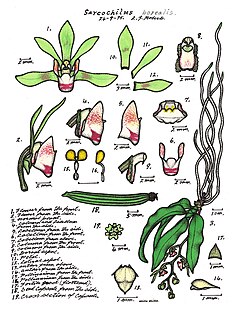
Dendrobium cunninghamii, commonly known as winika, pekapeka, Christmas orchid, bamboo orchid or ladies slipper orchid, is a species of epiphytic orchids that is endemic to New Zealand. It is commonly found growing in rainforest in the North, South, Stewart and Chatham Islands and normally flowers in summer and early autumn.

Dendrobium discolor, commonly known as antler orchids, are epiphytic or lithophytic orchids in the family Orchidaceae. They have cylindrical pseudobulbs, each with between ten and thirty five leathery leaves, and flowering stems with up to forty mostly brownish or greenish flowers with wavy and twisted sepals and petals. Antler orchids occur in northern Australia, New Guinea and Indonesia and there are several subspecies and varieties.

Dendrobium tetragonum, commonly known as the tree spider orchid, is a variable species of epiphytic or lithophytic orchid endemic to eastern Australia. Tree spider orchids are unusual in having pendulous pseudobulbs that are thin and wiry near the base then expand into a fleshy, four-sided upper section before tapering at the tip. There are only a few thin but leathery leaves at the end of the pseudobulbs and up to five flowers on relatively short flowering stems. To allow for the variations in the species there are five subspecies and a variety, some with a unique common name.

Sarcochilus falcatus, commonly known as the orange blossom orchid, is a small epiphytic or lithophytic orchid that is endemic to eastern Australia. It has up to eight, leathery leaves with fine teeth on the edges and up to twelve white to cream-coloured flowers with a white labellum that has orange and purple markings.

Dendrobium falcorostrum, commonly known as the beech orchid, is a species of epiphytic orchid endemic to eastern Australia. It has spindle-shaped pseudobulbs, each with between two and five leathery leaves and up to twenty crowded white flowers with purple markings on the labellum.

Dendrobium cucumerinum, commonly known as the cucumber orchid or gherkin orchid, is a species of orchid endemic to eastern Australia. It is an epiphytic orchid with creeping stems, gherkin-like leaves and flowering stems with up to eighteen cream-coloured, yellowish or greenish white flowers with purple stripes. It often grows on large trees near streams but is also found in drier forests.

Dendrobium pugioniforme, commonly known as the dagger orchid is a species of orchid endemic to eastern Australia. It is an epiphytic or lithophytic orchid with pendulous, wiry stems, fleshy, sharply pointed leaves and flowering stems with one or two greenish or yellowish flowers with a white labellum. It grows on trees and rocks, mostly in humid forest.

Dendrobium schoeninum, commonly known as the common pencil orchid, is an epiphytic or sometimes a lithophytic orchid in the family Orchidaceae and has thin wiry, upright or pendent stems with fleshy, grooved, dark green leaves. Its short flowering stems have one or two, rarely up to four pale green, cream-coloured or mauve flowers with purple markings on the labellum. It grows on rainforest margins in coastal New South Wales and southern Queensland.

Dendrobium bifalce, commonly known as the native bee orchid, is an epiphytic or lithophytic orchid in the family Orchidaceae. It has spindle-shaped pseudobulbs with up to four leathery leaves and up to ten pale green or greenish yellow flowers with purplish markings. It grows on trees and boulders in rainforest in tropical North Queensland, Australia and in New Guinea.
Dendrobium epiphyticum, commonly known as the Illawarra rock orchid, is a species of epiphytic or lithophytic orchid that is endemic to New South Wales. It has tapered or cylindrical pseudobulbs, up to five thick, leathery leaves and up to fifty cream-coloured or pale yellow flowers with reddish purple markings on the labellum.
Saccolabiopsis armitii, commonly known as the spotted pitcher orchid, is an epiphytic orchid from the family Orchidaceae. It has a short stem, coarse, wiry roots, between three and six crowded, curved leaves and up to fifty yellowish green flowers with red markings and a white labellum. It usually grows in coastal scrub to rainforest in New Guinea and tropical North Queensland, Australia.
Sarcochilus argochilus, commonly known as the northern lawyer orchid, is a small epiphytic orchid endemic to Queensland. It has up to eight thin leaves and up to twelve small bright green to yellowish green flowers with a white labellum.

Sarcochilus australis, commonly known as the butterfly orchid or Gunn's tree orchid, is a small epiphytic orchid endemic to eastern Australia. It has up to ten oblong, dark green leaves and up to fourteen small green to yellowish or brownish flowers with a mostly white labellum.

Sarcochilus borealis, commonly known as the small lawyer orchid, is a small epiphytic orchid endemic to Queensland. It has up to six thin but stiff, dark green leaves and up to ten green flowers with a white labellum that has reddish brown markings.
Sarcochilus dilatatus, commonly known as the brown butterfly orchid, is a small epiphytic orchid endemic to eastern Australia. It has up to twelve, thin, leathery, dark green leaves and up to twelve brown or reddish brown flowers with a mostly white and yellow labellum.

Sarcochilus hillii, commonly known as myrtle bells, is a small epiphytic orchid native to eastern Australia and New Caledonia. It has up to ten drooping, quill-shaped leaves and up to ten frosty white or pink flowers that have a hairy labellum with purple stripes.

Sarcochilus hirticalcar, commonly known as the harlequin orchid, is a small epiphytic orchid endemic to Queensland. It has up to eight bright green leaves and up to twelve cream-coloured to bright yellow flowers with purplish to reddish brown bands.

Sarcochilus serrulatus, commonly known as the banded butterfly orchid, is an epiphytic orchid endemic to tropical North Queensland. It has up to six crowded leaves with finely toothed and wavy edges and up to ten reddish brown flowers with a white, yellow-banded labellum.
Sarcochilus spathulatus, commonly known as the small butterfly orchid, is a small epiphytic orchid endemic to eastern Australia. It has a single, more or less pendent growth with up to ten thin, leathery leaves and up to five green to dark brown flowers with a cream-coloured labellum that has purple markings.
Sarcochilus weinthalii, commonly known as the blotched butterfly orchid, is a small epiphytic orchid endemic to eastern Australia. It has between three and seven thin, leathery, yellowish green leaves and up to twelve cream-coloured flowers with large purple or reddish blotches.














